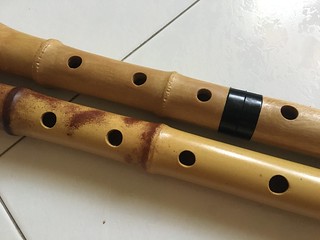The Shakuhachi (尺八) is elegant through its simplicity - 5 finger holes being sufficient to bring out the chromatic scale reaching up to 3 octaves.
It is interesting how the Japanese innovated on this by looking outside of the box. A typical wind instrument has precise finger holes to determine the pitch. To illustrate, a hole can be in two states, either opened or closed, and each state produces its own pitch so there are two notes available.
For the Shakuhachi, each finger hole has a wider diameter than say a Xiao or recorder. This means each hole can be partially covered or shaded to access the finer pitches in-between two discrete notes. This in itself is not unique as there are other flutes like the North American Flute (NAF) that have half-hole techniques.
For greater versatility, the Shakuhachi can be blown with variation in the angle between the blowing edge and the lips (embouchure). And this gives the performer another means to control pitch. Such pitch variations through head tilting plus instrument shifting is also used for vibrato effects.
For example, the note D is played by covering all holes (on a 1.8 Shakuhachi) while lifting finger off the first (lowest) hole plays F. The notes E and Eb (E flat) are "hidden" between D and F. Magically through partial fingering and angle adjustment, these notes shyly manifest.
These "half" sounds are usually softer in volume and differ in timbre from a fully opened/closed finger hole note. Such imperfections contribute to the distinct sound signagure of a Shakuhachi, enriching the palette available to an expert player to convey different moods and imagery.
There is an inherent "uncertainty" or variability to each note produced, therefore the same song can sound anew when repeated even by the same performer.

No comments:
Post a Comment